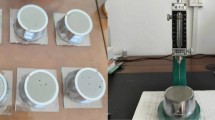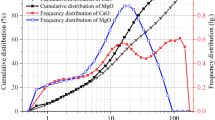Abstract
To solve the problems of insufficient dry air coverage of the external dry air supply dehumidification system commonly used in the main cable of the suspension bridge, a new dehumidification system is proposed to dehumidify the main cable by delivering dry air from inside the main cable. The new dehumidification system changes the dry air delivery method of the traditional dehumidification system, and the dry air is delivered from the center of the main cable section, which can effectively solve insufficient dry air coverage in the main cable. Based on the 1560 m long-span suspension bridge of Longtan Yangtze River Bridge, the overall design of the new dehumidification system for the main cable is carried out. The composite air supply conduit is designed to meet the internal compressive strength requirements and adapt to the longitudinal deformation of the main cable. A dehumidification test is carried out to verify the feasibility of the new dehumidification system and evaluate its dehumidification effect. The results show that the composite air supply conduit composed of high-strength steel wire spring and corrugated pipe can withstand the radial compressive stress of 13.4 MPa and meet the compressive strength requirement inside the main cable. Therefore, it can be used as the dry air delivery conduit of the new dehumidification system for the main cable. The dry air of the new dehumidification system can achieve full coverage of the cross-section of the main cable, and the relative humidity of each position in the main cable can be reduced to below the critical humidity (RH = 60%) for the high-strength steel wire corrosion. That is, the entire main cable can be better protected against corrosion. Thus, the new dehumidification system can provide a new effective anti-corrosion measure for the main cable of the large-span suspension bridge.



















Similar content being viewed by others
Data availability
The authors declare that any underlying research materials related to this paper (for example data, samples or models) can be accessed.
References
Chen C (2012) Latest research progress of main cable dehumidification system of suspension bridge in China. Eng Sci 12(4):95–99
Shoichi S, Kazuhiko F (2003) Corrosion protection of suspension bridge cables. Constr Civ Eng Struct 63(7):35–37
Nakamura S, Suzumura K (2012) Experimental study on repair methods of corroded bridge cables. J Bridg Eng 66(4):720–727
Suzumura K, Nakamura S (2004) Environmental factors affecting corrosion of galvanized steel wires. J Mater Civ Eng 16(1):1–7
Karanci E, Betti R (2018) Modeling corrosion in suspension bridge main cables. II: Long-term corrosion and remaining strength. J Bridge Eng 23(6):04018026
Liu ZX, Guo T, Han DG, Li AQ (2020) Experimental study on corrosion-fretting fatigue behavior of bridge cable wires. J Bridge Eng 25(12):04020104
Xue SL, Shen RL, Chen W, Shen LL (2020) The corrosion-fatigue measurement test of the Zn–Al alloy coated steel wire. Structures 27:1195–1201
Watkinson DE, Rimmer MB, Emmerson NJ (2019) The influence of relative humidity and intrinsic chloride on post-excavation corrosion rates of archaeological wrought iron. Stud Conserv 64:1–16
Zhang QX, Zhao HW, Fang Y et al (2020) Application progress on corrosion and protection of main cable steel wire of suspension bridge. J Nanjing Tech Univ (Nat Sci Ed) 42(3):278–283
Wan TB, Chen W, Shen RL et al (2020) Overall design of dehumidification system for long-span suspension bridge on dry air conveying inside main cable. Bridge Constr 50(S2):55–61
Scindia S, Elnahal S, Colford B et al (2018) Dehumidification breathes new life into suspension cables on the Delaware memorial bridges. In: International Bridge Conference 2018. Maryland, USA, pp 29–38
Nader M, Baker G, Duxbury J et al (2015) Chesapeake bay bridge dehumidification design. In: Sustainable bridge structures
Chen KL (2019) New development of bridge long life research in Japan. World Bridges 47(2):50–54
Li H (2005) Design and construction of dehumidification system for main cables of suspension bridge of Runyang bridge. Bridge Constr 01:39–44
Cocksedge C, Bulmer MJ (2009) Extending the life of the main cables of two major UK suspension bridges through dehumidification. Bridge Struct 5(4):159–172
Chen W, Shen RL, Wan TB et al (2021) Pressure loss of internal dry air supply dehumidification system in main cable of suspension bridge. J Southeast Univ (Natl Sci Ed) 51(02):227–234
Xu FY, Chen YL, Zheng XL et al (2019) Experimental study on corrosion and mechanical behavior of main cable wires considering the effect of strain. Materials 12(5):753
Miao RS, Shen RL, Wang L et al (2020) Theoretical and numerical studies of the slip resistance of main cable clamp composed of an upper and a lower part. Adv Struct Eng 24(04):691–705
Shen RL, Chen W, Chen X, Miao RS. A high pressure and high elongation pipeline structure. CN210088192U,2020-02-18.
Shakya AM, Kodur V (2016) Effect of temperature on the mechanical properties of low relaxation seven-wire prestressing strand. Constr Build Mater 124(15):74–84
Zhong T (2015) Mechanical properties of prestressing steel after fire exposure. Mater Struct 48(9):3037–3047
Du Y, Peng JZ, Richard-Liew JY et al (2018) Mechanical properties of high tensile steel cables at elevated temperatures. Constr Build Mater 182(10):52–65
Peng GZ, Miao XP, Jia DY et al (2013) Design research on dehumidification system for main cable of suspension bridge. J Shenzhen Univ (Sci Eng) 30(2):179–185
Wei ZJ, Peng FS, Miao XP et al (2016) Numerical calculation and experiment on the dehumidification system for main cable of suspension bridge. J Eng Thermophys 37(12):2495–2501
Acknowledgements
This study was funded by National Natural Science Foundation of China [51178396/E080505] and Project of Transportation Science and Technology of Jiangsu Province. The financial support from these grants is gratefully acknowledged.
Author information
Authors and Affiliations
Corresponding author
Additional information
Publisher's Note
Springer Nature remains neutral with regard to jurisdictional claims in published maps and institutional affiliations.
Rights and permissions
About this article
Cite this article
Chen, W., Shen, R., Que, M. et al. New dehumidification system design and dehumidification test for the main cable of suspension bridge. J Civil Struct Health Monit 11, 1321–1335 (2021). https://doi.org/10.1007/s13349-021-00513-9
Received:
Revised:
Accepted:
Published:
Issue Date:
DOI: https://doi.org/10.1007/s13349-021-00513-9




